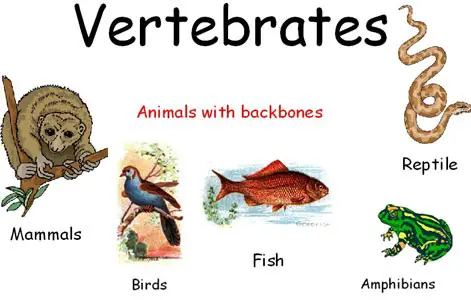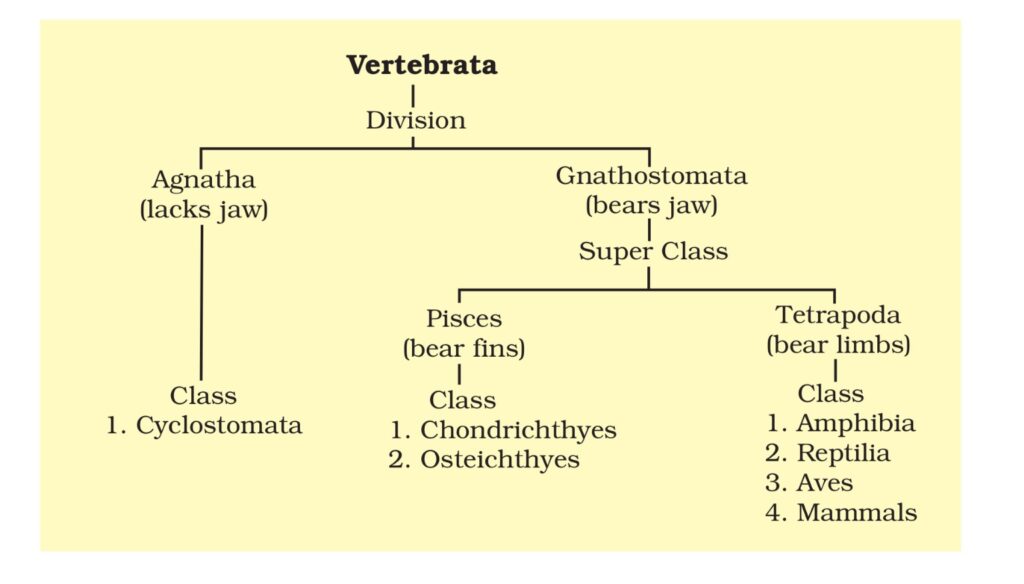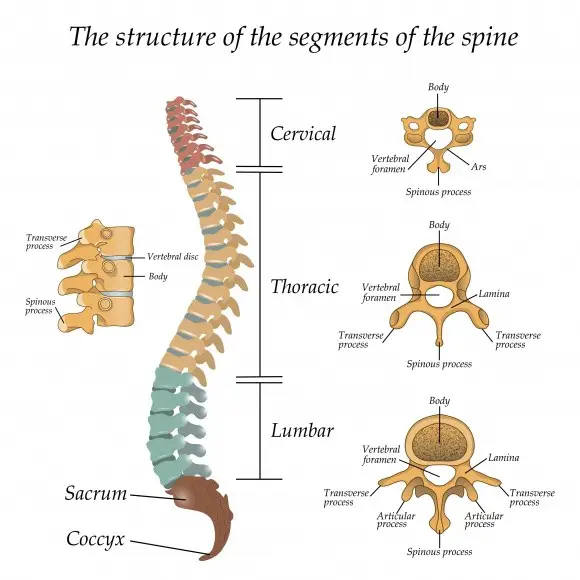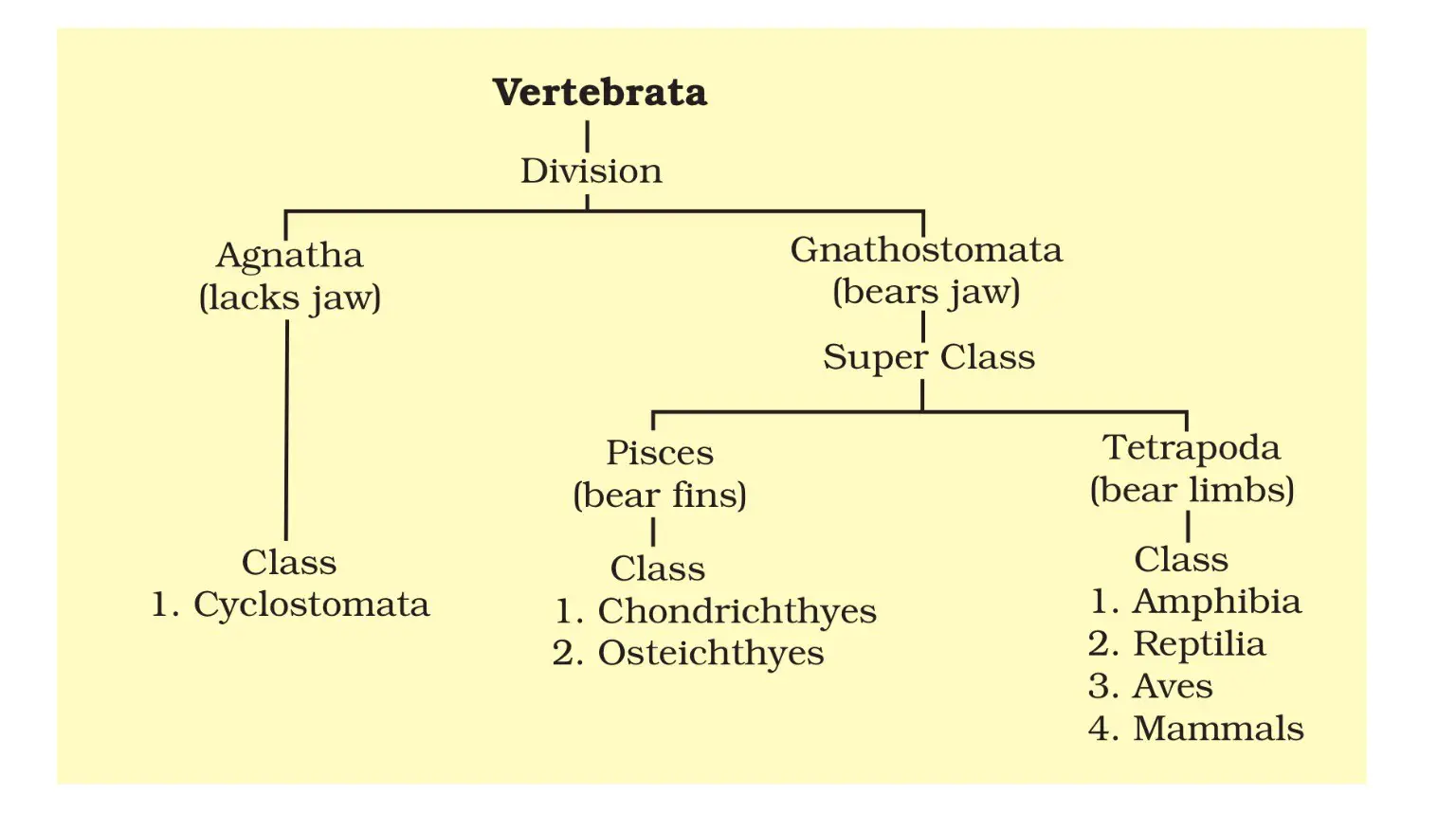Lower Vertebrate and Higher Vertebrate:
In Vertebrate we find cranium or brain box and vertebral column along with other Chordate Characteristics, dorsal hollow nerve cord, notochord, pharyngeal gill slits. But all the members of Vertebrate do not show all the advanced features present in today Vertebrate and some of them have primitive Vertebrate characters while some have modern Vertebrate characters.

Based on the characteristics present in the Vertebrate we classify them into two different groups, lower Vertebrate, and Higher Vertebrate.
| Lower Vertebrate | Higher Vertebrate |
| Lower Vertebrate is also known as Anamniota because in lower Vertebrate the Amnion remains absent in the extraembryonic membrane. | Higher Vertebrate have all the four extraembryonic membrane structures, allantois, amnion, chorion, and yolk sac so they are known as Amniota. |
| The Vertebrate classes arose earlier, class Cyclostomata, class Chondrichthyes, Osteichthyes, Amphibia known as lower Vertebrates. | The other classes of subphylum Vertebrate, class Reptilia, class Aves, class Mammalia are known as higher Vertebrate. |
| As the ancestral Chordata and ancestral Vertebrate arise in water first so the members of lower Vertebrate live in the aquatic environment. | Amphibia first come on land and then the higher Vertebrate become terrestrial and they generally spend on land. |
| In an aquatic environment, all the organisms generally do not have a neck and the body is generally divided into three parts, head, trunk, and tail. | Higher Vertebrate is generally terrestrial and generally has four body parts, head, neck, trunk, and tail. |
| In earlier classes of lower Vertebrate have fin as paired appendages but in some cases limbs also present. | The higher Vertebrate is mostly terrestrial so no need for fin, they generally have paired limbs. |
| Lower Vertebrate is generally aquatic and the needs of an exoskeleton are not much, in some cases dermal scales present as an exoskeleton. | The body has different types of exoskeleton, hair, nail, claw, horns, feathers, epidermal scales. |
| The Chordata features pharyngeal gill slits present throughout life. | As they are generally terrestrial and do not need gill so the pharyngeal gill slits are only present in the embryonic stage but disappear in the adult stage. |
| The notochord is associated with cartilaginous tissues, the notochord is generally persistent, it shows segmentation. | The notochord is only present in the embryonic stage but in the adult stage, the notochord is from the vertebral column. |
| Endoskeleton is generally formed by cartilaginous tissues in all lower Vertebrates. | In a higher Vertebrate, the exoskeleton is made of both cartilaginous tissue and bony tissue, but the cartilaginous tissues are present in very few amounts. |
| The heart has either two chambers or 3 chambers, the oxygenated and deoxygenated blood mix easily. | In reptiles, the heart is incompletely 4 chambered but other higher Vertebrates have four-chambered heart. |
| Lower Vertebrates are unable to control constant body temperature, the body temperature varies with the external environment, they are Poikilothermic. | Higher Vertebrate except for the reptiles, Aves and Mammalia are Homieothermic, so they can keep their body temperature constant. |
| Lower Vertebrates are aquatic so they need gill for respiration. | Higher Vertebrates are generally terrestrial so they respire through lungs, some other respiratory organs are also present in higher Vertebrates. |
| The excretion occurs through mesonephric kidneys in the lower Vertebrate. | In higher Vertebrate, the excretory organ is generally metanephric kidneys but mesonephric kidneys are also present. |
| The number of the cranial nerve is less than in higher Vertebrates, with 10 pairs of cranial nerves present. | The number of the cranial nerves is more in the higher Vertebrate, with 12 pairs of cranial nerves present. |
| Where sexual dimorphism is present, the male copulatory organ does not present. | In higher Vertebrate copulatory organ present but in Aves male copulatory organ remain absent. |
| Fertilization externally occurs in water, development is indirect. | Fertilization internal, development is direct without any larval stage or metamorphosis. |


Detailed Study On Subphylum Vertebrata Definition Characteristics Classification Examples and Diagram
Reference
Basis of Classification in Subphylum Vertebrata
Phylogeny of Subphylum Vertebrata
An Overview of Classification in Subphylum Vertebrata
Subphylum Vertebrata and its Diversity
Cephalochordata Characteristics Features Classification Examples and Diagram
Urochordata Classification Morphology Characteristic Features
Characteristics Features of Hemichordata
General Comparison of Hemichordata Urochordata and Cephalochordata
Comparative Study of Digestive System in Hemichordata Cephaochordata and Urochordata
Characteristics Features of Subphylum Vertebrata
Hi Everyone!!! Welcome to Imaluop. Imaluop always try to learn some new and he want to share to other people. Here we will try to learn various topics on Science, specially on Biological Sciences.
